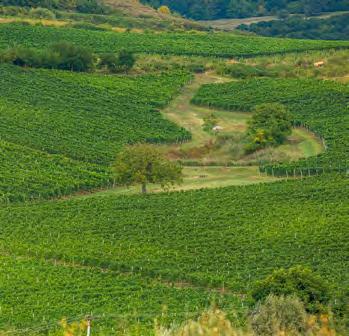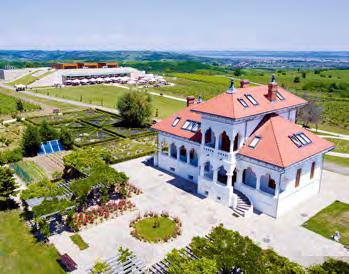
5 minute read
Something old
from BR/10/2020
Something old, something new, something bubbly: The potential of wine tourism in Romania
It’s still harvest time in some areas of Romania, for one of the country’s best kept souvenirs: grapes. But is there more to Romanian vineyards than enjoying some grape-picking and wine tasting?
Advertisement
By Oana Vasiliu
It’s the season to enjoy nature at its best and get bubbly all the way
ONCE UPON A TIME Romania has been cultivating grapes for a long period of time, but its history as a wine producer is rather fractured. While growing grapes dates as far back as 5,700 BC, Romania’s modern wine industry only developed once the Communist period ended, meaning it’s barely 30 years old. The once-nationalised wine industry was then privatised and received considerable investment from overseas, mainly from Italian, Austrian, German, French, and British companies, which helped build new facilities and replanted vines to increase both the quality and quantity of the wine.
The magazine “The Drinks Business” writes that according to OIV data from 2019, Romania is Europe’s sixth and the world’s 13th largest wine producer, yielding 4.9 million hectolitres last year. Most of this wine, however, does not leave Romania. In 2018, the country exported just 3.5 percent of its total production. “To put this in context, Romania makes more wine than New Zealand, Greece and Hungary, but exports less than Denmark, Austria, Slovakia, and Bulgaria,” explains Phoebe French from “The Drinks Business”.
THE WINE TOURISM BUSINESS One of the biggest promoters of wine tourism in Romania is Alina Iancu from Crame Romania and Revino, who manages a website where people can find information about vineyards, their availability for accommodation, and other facilities they offer. Last year, around 70 wineries in seven wine areas of Romania were opened to visitors. This year, about 20 wineries are offering accommodation in guesthouses nearby. A visit to a winery includes a presentation of the winemaking process, the tasting of five to seven types of wine, and, if the weather allows it, a walk through the vineyards. “Wine tourism can happen at any time of year and benefits wineries in the sense that they can sell some of their wine to visitors, and small wineries may end up selling 10-15 percent of production right on site,” adds Alina.
“Tasting rooms have started to appear lately, as well as more events and a greater interest in the wine business, and that’s good, but the demand is not large enough for wineries to have dedicated staff for wine tourism. During the summer, tourists also visit on weekdays, but during the rest of the year, wine tourism remains more of a weekend thing,” Alina Iancu notes.
This year, wineries faced a new challenge, besides the drought. “With little to no activity in the hospitality sector for more than three months, wineries have large stocks of wines and now, in the middle of the harvest, they need to make space for this year’s wine harvest, so they have to get rid of the stock somehow,” Iancu explains.
THE VINEYARD’S SIDE OF STORY Jardine Hills, located 100 kilometres from Bucharest, had the best summer on record. “We were basically fully booked every weekend after May 15, when the COVID-19 restrictions were eased, as well as on most weekdays. Our cottages provide safe and clean accommodation near Bucharest for friends and families to be able to socially distance while still having a nice time, so they have become very popular. We are currently fully booked for every weekend through to the end of October,” the
Chill vibes at Jardine Hills

owners tell Business Review. Accommodation starts from EUR 150 and they have eight rooms available, split between three cottages which are rented entirely.
For Avincis, wine tourism started in 2011, when they opened up the manor, the Avincis winery, 43 hectares of vineyards, several hectares of forestland, and landscaping sights. This summer was particularly busy for them too, as tourists opted for local destinations. At Vila Dobrusa, the accommodation facility, tourists can choose from 9 double rooms and 3 apartments and also enjoy good meals, wine tasting, a tour of the winery and walks through the vineyard. A package for two people including one night of accommodation, meals, and tasting 5 wines starts from RON 710.
The Liliac Winery was founded in 2010 and had two landmark buildings in the Batos village. One was the winery, located inside the village, where the magic of transforming grapes into wine takes place, and the other is Liliac Lodge, the tasting cabin, located in the middle of the vineyard, above Batos, where you can be enchanted by the vines stretching over the hills, the fabulous view, and the tranquillity of the place. This Lodge has only one room available, with a price starting from RON 670, all experiences included. Wine tastings have been taking place here since the launch of the first Liliac wines in 2012, and they’ve been offering accommodation to visitors since 2018.
BABY STEPS: DEALU MARE ASSOCIATION PROMOTES BOTH VINEYARDS AND WINEMAKERS The Dealu Mare Association was the first Romanian collective initiative who managed to enact updates to the legislation and conditions under which the wines of one region

Road to Crama Liliac

Vila Dobrusa is surrounded by their wineyards
- Dealu Mare - are produced. “The Dealu Mare initiative is an exception, and it was the result of the associates understanding that in order to protect the name of the region on an increasingly competitive market, they had to upgrade standards and communicate a strong message to the market together. It all started with a small group of people - the owners and managers of Davino, SERVE, Budureasca, Tohani, Aurelia Visinescu, and Viile Metamorfosis, the oldest wineries in the area and among the most reputable – and others soon joined,” says Cezar Ioan, one of the promoters of the Association. “I strongly believe that people visiting wineries and vine plantations to see where wine comes from and how it’s made and meet the people who make it is the best way to promote wines and wine culture. It goes well beyond simple tastings, as these types of actions establish strong and meaningful connections between producers and consumers – not to mention the fact that this is the best way to educate the people working in hospitality about wine,” Cezar Ioan argues.






